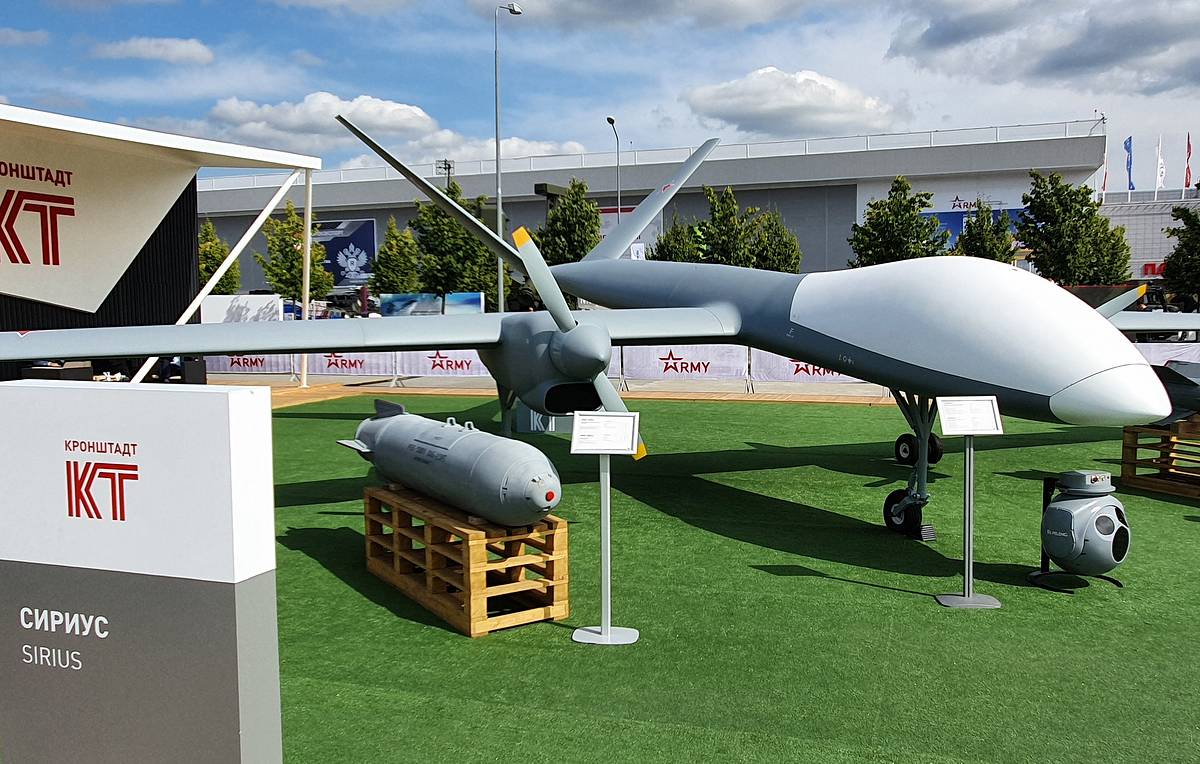After losing three Su-34s to a Ukrainian ‘air-defense ambush,’ with possibly US-origin Patriot PAC-3 that Ukraine operates, the Russian defense industry has hinted it has completed all deliveries of an unknown aerial weapons system that also poses a credible threat to Ukrainian ground positions.
Russia To Retire World’s Only Nuclear-Powered, Largest Battle-Cruiser Pyotr Veliky; Sister Ship To Serve In Arctic
While media reports from Russia that quote the representatives from the developer have not identified the system, the Russian Air Force’s (RuAF) prior operational history, press coverage about its ongoing programs, and the framing of the report itself strongly suggest it is the Sirius Unmanned Combat Aerial Vehicle (UCAV).
Russia has long been reported to be deficient in Medium/High-Altitude Long-Endurance (MALE/HALE)-class reconnaissance-strike UCAV like the US MQ-9 Predator. Such platforms offer tremendous semi-strategic advantages by combining long-duration flight times with air-to-ground strikes using guided missiles and bombs.
Russia introduced some units of the Sirius earlier this year, but a larger fleet allows for covering a larger area of the 600-kilometer frontline in the east and south of Ukraine.
Russia recently lost three Su-34s that were being used to release FAB-500 and other unguided drop bombs with Universal Module for Planning and Correction (UMPC) modules that turned them into smart glide bombs.
The munitions caused a devastating impact on Ukrainian positions for nearly three months. This was particularly complicated by the fact that they are invulnerable to any known Soviet or Western air defense system with Ukraine, since they have no rocket exhaust or electromagnetic emissions for surface-to-air missiles to lock on to.
Sirius UCAV
The reconnaissance and strike drone Sirius is a further development of the Orion UAVs and is powered by two turboprop engines, unlike the Reaper’s single power plant, with a claimed flight duration of approximately 20 hours.

The maximum height is 7000 meters (23,000 feet), with a cruising speed of 180 km/h and a range of 3,000 kilometers. Also, various sources claimed that this UAV would be equipped with its own satellite communications system.
Drone Developer Delivers Unidentified UAV ‘Ahead of Schedule’
A TASS report quoted a statement from the St. Petersburg-based Joint Stock Company (JSC) Kronstadt, which developed the Sirius UCAV, also known as the Inokhodets-RU. The aerospace company merely claimed to have met its order book with the Russian military without revealing the nature of the “deliveries.”
JSC Kronstadt “announced” that it “completed deliveries under the state defense order ahead of schedule.” “The organization refused to clarify information about the supplied products,” the report added. “Thanks to coordinated work, the enterprises of the Kronstadt company, including the Dubna Machine-Building Plant, completed deliveries within the framework of the state defense order ahead of schedule,” the company said.
Dubna is possibly involved in manufacturing components, advanced assemblies, sub-assemblies, and precision parts for the system – assumed to be the Sirius UCAV. Whether it is a vendor for Kronstadt or an assembly and integration factory as well that puts together the final product, is unclear.
The report then concludes by identifying the nature of projects at Kronstadt and naming Sirius in that context, but not with reference to the latest order it claims to have met. “JSC Kronstadt is a full production cycle enterprise for the creation of unmanned aerial systems. The company is the developer and manufacturer of the Orion attack drone, also known as the Pacer.”
The fact that the unidentified weapon platform is the Sirius UCAV can also be confirmed by a closer look at Dubna. Interestingly, Dubna has been placed under international sanctions, among dozens of Russian bodies and officials, after following the war. The website Open Sanctions mentions JSC Dubna (or Dubnensky) as a sanctioned entity that is “entirely contributing to Russia’s military-industrial complex.”
“The company develops Orion reconnaissance and strike drones, as well as maritime drones for the Russian armed forces. Drones manufactured by Dubnensky Machine-Building Plant JSC have been equipped with guided missiles. Between February and Apr 2022, there were six confirmed kills in Ukraine by Russian Orion drones manufactured by Dubnensky Machine-Building Plant JSC,” the website said.
The company’s own website, which identifies itself as the Pelcom Dubna Machine-building factory, says it specializes in “mechanics, electrical engineering, hydraulics, pneumatic automation, electrics, electronics, software, and laser technologies development.” These systems constitute drones and aircraft.
Sirius Drones Will Always Be Overhead
A previous EurAsian Times article described how MALE/HALE-class UAVs tremendously boost Russian ground operations by giving an early warning about any Ukrainian field maneuvers while also collecting targeting data for both aerial strike platforms and ground formations.
Typical with Russian doctrine, Sirius forms a “reconnaissance and fire networked circuit” with Su-34, Su-25 strike aircraft, Ka-52, and Mi-28 heavy attack helicopters, artillery batteries, and ground units by staying safely behind the frontlines.
With more such drones active, Ukraine will find it even more difficult to launch surprise ground raids with infantry or artillery on Russian positions along the entire frontline, and not just certain patches where Sirius drones are not operating.
Kyiv has successfully restricted Russia’s ability to use UMPC-enabled bomb-dropping fighter bombers like the Su-34s. But the victory has also coincided with Russia’s failing efforts to compensate for its weakness in UAVs and strengthen its drone sector, which is beginning to bear fruit.
- The author can be reached at satamp@gmail.com
- Follow EurAsian Times on Google News




